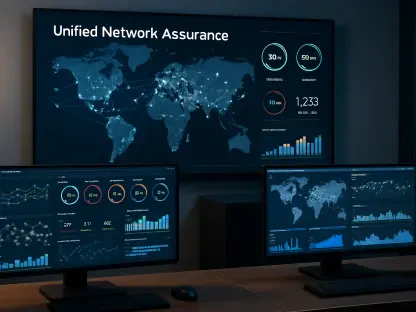In a digital landscape where cyber threats evolve at an alarming pace, staying ahead of vulnerabilities is a constant challenge for organizations worldwide, and the latest Patch Tuesday update from Microsoft, analyzed in detail by a leading cybersecurity firm, offers critical insights into the current state of software security. Every second Tuesday of the month, Microsoft rolls out its batch of security fixes, addressing flaws in widely used products like Windows and Office that, if left unpatched, could serve as open doors for malicious actors. The August release is particularly noteworthy, with a substantial number of patches tackling a broad spectrum of risks. This analysis dives deep into the specifics of the update, shedding light on the most pressing vulnerabilities, the nature of the threats they pose, and the broader implications for IT environments. From zero-day exploits to critical flaws that could enable remote code execution, the scope of this update underscores the relentless nature of cyber risks. It also highlights the importance of timely action to safeguard systems against potential breaches. As the digital world becomes increasingly interconnected, understanding these updates is not just a technical necessity but a strategic imperative for maintaining robust defenses against sophisticated attacks.
Digging into the August Update Details
Microsoft’s latest security update for August addresses a staggering 107 vulnerabilities across its product lineup, a number that speaks volumes about the ongoing battle to secure software ecosystems. Among these, one zero-day vulnerability has already been publicly disclosed, alongside 13 critical flaws that demand immediate attention. The sheer volume of patches reflects the complexity of protecting systems that millions of users and organizations depend on daily. Windows, as expected, bears the brunt of the fixes with 67 patches, emphasizing its role as a primary target for attackers. Extended Security Updates follow with 48 patches, while Microsoft Office accounts for 19, illustrating how productivity tools remain in the crosshairs of cyber threats. This distribution of fixes across core systems and essential applications points to the diverse attack surfaces that need constant vigilance.
A closer look at the types of vulnerabilities reveals a troubling pattern, with elevation of privilege flaws leading the pack at 42 patches, comprising 39% of the total. Remote code execution issues are not far behind, with 35 patches, while information disclosure vulnerabilities make up 16 of the fixes. These categories highlight the primary methods attackers use to compromise systems, whether by gaining unauthorized access levels or executing malicious code remotely. The prevalence of such risks in widely used software underscores the urgency of applying these patches promptly. For IT teams, the challenge lies not just in deploying updates but in prioritizing those that address the most severe threats to prevent potential exploitation before it occurs.
Emerging Patterns in Cyber Threats
The analysis of this month’s Patch Tuesday update reveals recurring themes in the cybersecurity landscape that are impossible to ignore. Elevation of privilege and remote code execution vulnerabilities dominate the list, signaling a persistent focus by attackers on mechanisms that allow deeper system access or the ability to run harmful code without detection. These types of flaws can devastate a system’s security by undermining confidentiality, integrity, and availability—the foundational pillars of data protection. Components such as the Windows Graphics Component and GDI+ are frequently targeted, turning routine user actions into potential entry points for attacks. This trend illustrates how adversaries continue to exploit the interconnected nature of modern software to maximize their impact.
Another alarming insight is the capability of many vulnerabilities to be exploited without any user interaction, amplifying their danger significantly. Such flaws can be triggered silently over network connections or through automated processes like document parsing, meaning victims might not even realize an attack is underway until it’s too late. While some issues, like the zero-day in Windows Kerberos, are already public knowledge, many critical vulnerabilities were undisclosed prior to the patch release, creating a window of uncertainty. Exploitation likelihood varies across the board, with certain flaws deemed more attractive to attackers due to minimal access requirements. This unpredictability necessitates a proactive stance, ensuring that systems are fortified before threats materialize into active exploits.
Spotlight on High-Impact Vulnerabilities
Among the numerous fixes in the August update, certain vulnerabilities stand out due to their severity and potential impact on system security. The publicly disclosed zero-day in Windows Kerberos, identified as CVE-2025-53779, carries a moderate severity rating but poses a significant risk of elevation of privilege. It allows attackers with existing high-level access to escalate further to domain administrator status over a network connection, without requiring any user action. Although no active exploitation has been reported, the availability of functional exploit code makes this a pressing concern. Organizations must act swiftly to apply the provided fix, as a breach at this level could compromise entire domain environments with severe consequences.
Equally concerning is a critical remote code execution flaw in the Windows Graphics Component, cataloged as CVE-2025-50165, with a near-perfect CVSS score of 9.8. This vulnerability can be exploited by something as innocuous as a malicious JPEG embedded in a document, enabling attackers to achieve full system compromise without any user interaction. A parallel critical issue in GDI+, under CVE-2025-53766, also scores 9.8 and exploits metafiles in documents or web services for remote attacks. Both flaws highlight the stealthy nature of modern threats, where everyday activities can become vectors for catastrophic breaches. Immediate patch deployment is essential to mitigate these risks before they are weaponized.
Adding to the urgency, a critical elevation of privilege vulnerability in Windows NTLM, identified as CVE-2025-53778, scores 8.8 on the CVSS scale and is flagged as more likely to be exploited due to its low privilege entry point. This flaw allows authenticated attackers to jump to SYSTEM-level access over a network, posing a dire threat to system integrity. Microsoft Office products also face multiple critical remote code execution vulnerabilities, exploitable via the Preview Pane without user engagement. These, alongside severe bugs in Microsoft Message Queuing and Azure components, paint a picture of a sprawling attack surface that demands comprehensive attention from IT security teams to prevent devastating outcomes.
Navigating Broader Security Implications
Beyond the immediate scope of this month’s patches, the update sheds light on enduring challenges within the cybersecurity domain that organizations must address. The consistent targeting of privilege escalation mechanisms remains a top concern, as attackers often use these flaws as stepping stones to deploy ransomware or steal sensitive data. This focus on gaining higher access levels to inflict maximum damage aligns with broader industry observations about the evolving goals of cybercrime. Similarly, remote code execution vulnerabilities are growing more sophisticated, exploiting seemingly harmless user behaviors like opening files or previewing content, which complicates the task of securing everyday operations.
A critical deadline looms on the horizon with the end of support for Windows 10 scheduled for October this year. After this point, systems running the outdated operating system will no longer receive security updates, leaving them exposed to emerging threats. Transitioning to a supported operating system is not merely a recommendation but a fundamental requirement for maintaining a secure IT environment. This impending cutoff serves as a stark reminder of the importance of lifecycle management in technology deployments. Organizations must plan ahead to avoid falling into a vulnerable state, ensuring that their infrastructure evolves in tandem with security requirements to withstand the relentless pace of cyber threats.
Strategies for Effective Threat Mitigation
Turning insights into action, the August Patch Tuesday update emphasizes the critical need for rapid patch deployment, especially for vulnerabilities with high severity scores or heightened exploitation likelihood. IT teams face the daunting task of sifting through numerous fixes to prioritize those that pose the greatest risk to their specific environments. Leveraging advanced tools for vulnerability management can significantly streamline this process by providing real-time visibility into threats and offering prioritized remediation guidance. Such solutions enable organizations to focus their efforts on the most pressing issues, reducing the window of opportunity for attackers to exploit unpatched systems.
However, patching alone is not a silver bullet for cybersecurity. Historical incidents have shown that not all vulnerabilities can be addressed through immediate fixes, necessitating robust mitigation strategies for scenarios where patches are delayed or unavailable. Regular security assessments are vital to identify weaknesses before they can be exploited, while integrating advanced threat detection capabilities helps catch malicious activity in its early stages. A holistic approach that combines timely updates with proactive defense measures is essential for building resilience against the ever-changing threat landscape. As cyber risks continue to evolve, staying ahead requires a commitment to continuous improvement and adaptation in security practices.
Reflecting on Key Lessons and Future Steps
Looking back, the August Patch Tuesday update served as a crucial reminder of the persistent vulnerabilities that plague Microsoft’s vast software ecosystem, with 107 flaws addressed, including a zero-day and multiple critical threats. The dominance of elevation of privilege and remote code execution issues underscored the sophisticated tactics attackers employ to breach systems. Microsoft’s swift response in providing fixes for nearly all identified issues was commendable, yet the analysis highlighted that relying solely on patches was insufficient for comprehensive protection. The looming end of Windows 10 support added a layer of urgency to the conversation around system updates and lifecycle planning.
Moving forward, organizations should focus on actionable steps to bolster their defenses, starting with the immediate application of critical patches while using risk assessment tools to prioritize remediation efforts. Developing contingency plans for unpatchable vulnerabilities, conducting frequent security audits, and ensuring a smooth transition to supported operating systems are vital measures to mitigate future risks. Embracing a multi-layered security strategy that integrates patch management with real-time threat monitoring will be key to navigating the complex cyber landscape. By learning from this update cycle, IT professionals can better prepare for upcoming challenges, safeguarding their environments against the next wave of digital threats.









